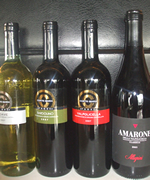Amarone from Valpolicella is a delicious red wine from Veneto and Allegrini is one of the top producers of this meditation wine which was the protagonist at a tasting last week at Manré Restaurant in the company of Alessandro Vallecchi, reports Subhash Arora
 When you think of the top wine of Valpolicella, Amarone comes to your mind first, followed by Amarone. Made by drying the grapes for 3-4 months after harvest in a humidity controlled chamber to avoid moulding, this unique process used in Valpolicella known as apassimento, gives a higher alcohol dry wine or sweeter wine with lower alcohol due to controlled fermentation, explained Alessandro Vallecchi, the Sales and Marketing Director of Allegrini Winery. When you think of the top wine of Valpolicella, Amarone comes to your mind first, followed by Amarone. Made by drying the grapes for 3-4 months after harvest in a humidity controlled chamber to avoid moulding, this unique process used in Valpolicella known as apassimento, gives a higher alcohol dry wine or sweeter wine with lower alcohol due to controlled fermentation, explained Alessandro Vallecchi, the Sales and Marketing Director of Allegrini Winery.
Amarone and in fact Valpolicella too is made from Corvina, Rondinello and Molinara-all indigenous grapes (that make Italian wines unique in flavours and style). It has been touted in Veneto as king of wines and wine of kings. Though best with red meats-grilled or roasted, it is also termed a meditation wine as one can spend hours sipping it in the company of good friends and hard and seasoned cheese, making it a potential favourite of the budding wine connoisseurs in India who can afford the rather high prices of this wine.
An interesting mixture of prune, flowers and hints of spicy bouquet is followed through to a full body, with firm tannins coating the mouth, with a long, fresh, mineral and fruity finish. The well-structured Amarone della Valpolicella Classico DOC 2003 was still a bit tight. Decanting for an hour or so would have helped it open up. But this had not been possible this afternoon. This Veneto beauty will reach its prime in 2-3 years but will drink for at least 10 years more. Also impressive was its low alcohol content of 15.5% ( I have tasted some with 16.5% and even more at the tastings in Valpolicella.
Earlier the afternoon started with the tasting of Soave Pagus Corte Giara 2007. Medium bodied white wine made from Garganega grapes was golden yellow-darker than most Soaves; more concentrated-said Alessandro, that made it last longer then the usual 1-2 years shelf life. Spicy and minerally, it needed to be chilled but was adequately cool. Valpolicella 2007 and Bardolino 2007 were the two other reds, the typical easy drinking wines with red cherry flavours from this area.
But the real surprise was the La Poja, which was not on the agenda but pulled out from the hat at Alessandro's suggestion. I had admired the La Poja hilltop vineyards while visiting their neighbourhood last year, when one could see sun's reflection in Lake Garda down below. Made from 100% Corvina grapes-the majority of Valpolicella wines are constituted of these grapes (max allowed 80%), this makes it an IGT wine- sort of a Super Venetian, but an iconic wine all the same.
 The 2005 (or was it 2004) was a breath-taking, full bodied, extremely complex wine with intense ruby red colour and exuberant aromas and flavours of blackberries, spices, mocha and dark chocolate. It was very expansive on the palate with flavours persistent on the mouth, ripe tannins creating a pleasant impression. The wine asked for red meats, though I enjoyed it even with the slightly spicy prawns. It was delicious with the mutton kebabs, though. I would have loved it with hard cheeses as well. The 2005 (or was it 2004) was a breath-taking, full bodied, extremely complex wine with intense ruby red colour and exuberant aromas and flavours of blackberries, spices, mocha and dark chocolate. It was very expansive on the palate with flavours persistent on the mouth, ripe tannins creating a pleasant impression. The wine asked for red meats, though I enjoyed it even with the slightly spicy prawns. It was delicious with the mutton kebabs, though. I would have loved it with hard cheeses as well.
UC Davis trained export manager Alessandro was very lucid in explaining the area, its history, the process and the wines.
Manré serving staff was very efficient and professional- the snacks were delicious and matched the wines rather well- even though one cannot take away the ease with which Valpolicella wines adjust with most foods because of their soft tannins and fresh acidity. The French General Manager, Laurent Guiraud who was discreetly supervising the service has done a very good job with training his staff.
Subhash Arora |